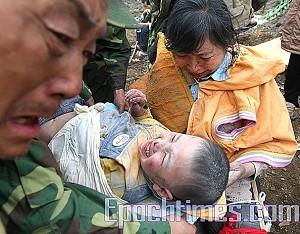SHIFANG, China—China struggled on Friday to bury the dead and provide aid to those left injured, homeless and without food and water by the earthquake that may have killed more than 50,000 people.
From the heart of the disaster zone in the southwestern province of Sichuan, where the 7.9 magnitude quake struck on Monday, Chinese Premier Wen Jiabao urged rescuers on, but hopes were fading for those still trapped under rubble.
About 20,000 are confirmed dead from the quake and at least another 25,000 remain buried.
In the Sichuan town of Yingxiu, where bodies were lined up along the river bank, a Communist Party official warned that epidemics could break out if bodies were not soon buried.
“We are in urgent need of body bags,” the official, Bai Licheng, told Xinhua.
“Air-dropped food and drinking water are limited and far from meeting the demand,” he added.
The Ministry of Health issued a notice ordering bodies to be cleaned where they were found and buried as soon as possible, far from water sources and downwind from populated areas.
More than 3,000 soldiers were racing the clock to search for survivors in Yingxiu, a township of about 6,600 people.
Bai said bodies were still trapped in the debris and blocked roads meant that heavy lifting gear could not get through.
China has mobilised 130,000 army and paramilitary troops to the disaster area, but the quake buckled roads and triggered mountain landslides, meaning that relief supplies and rescuers have struggled to reach the worst-hit areas.
Equipment Airdropped
In the Sichuan city of Shifang, a small hospital struggled to cope with injured patients, who were being treated in any space available—including a under a covered car park at the back of the building and under tents on the pavement.
Doctors and nurses rushed around, checking dressings, changing saline drips and administering to the wounded.
“We’ve seen nobody come here from the government,” said one woman, tending to her injured son.
“They’re trying to help, but they’ve been so busy,” added a young man standing next to her. “In Mianzhu alone there’s thousands dead,” he said, referring to a nearby area.
In the epicentre, Wenchuan, Chinese air forces succeeded for the first time on Thursday in airdropping rescue equipment, Xinhua said, citing military sources. Such airdrops had earlier been stymied by heavy rain and cloud cover.
The first foreign rescue team, a group from about 60 people from Japan, also reached Sichuan on Friday. China has accepted further offers of rescue teams from Russia, South Korea and Singapore, the Foreign Ministry said.
The disaster was the deadliest since a 1976 earthquake hit the northeastern Chinese city of Tangshan, killing up to 300,000 people.






Friends Read Free